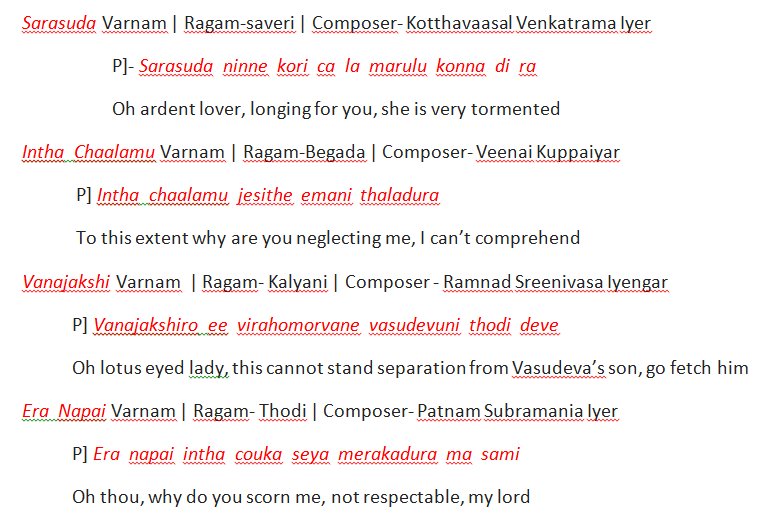
|
 |

|
 |
Tana varnams: The promise of more than an abhyasageetham - Mridula Anand e-mail: silambam05@yahoo.com July 7, 2019 Varnam, touted as the centerpiece of a dance recital, also brings out the nuances of the ragam that it is composed in. Composed of short metric pieces, varnams are a fundamental part of a recital. Normally a varnam consists of lyrics, swara passages such as a pallavi, anupallavi, muktayi swaras, charanam and chittaswarams. However not all varnams are similar. Commonly acknowledged types are the padavarnams, tana varnams and daru varnams. While pada varnams and daru varnams are found to be pervasive through angika, tana varnam were predominantly found through vachika - or vocal expression. Performed as the opening warm-up by musicians and as the piece de resistance by dancers, the significance of a varnam is generally accepted. As scholarly compositions, they serve as both the foundations for vocal musicians as well as help develop voice culture, and maintain proper pitch and control of rhythm. Further, they are often the stepping stones to develop an artist's manodharma (improvisation). Why are tana varnams not popular as performance pieces in Bharatanatyam? A look at the structure of the varnam might give us clues. Pada varnams are more lyrical, slow and have sahityas for all charana swaras. Thus they are often pegged to suit elaborate sringara and bhakthi showcases in dance. In the case of tana varnam, the poorvanga (first part) consists of a pallavi, anupallavi and muktayi swaram followed by the charanams (uttaranga). Typically in sama eduppu and madhayama kala, raga sancharas play a more pivotal role than sahityas. Further 'anubhandas' ensured a cyclical attempt to connect the charana with the swara patterns thus offering a link back into the varnam. Tana varnams are thus associated more with exposition of raga grammar and less to showcase abhinaya. However, let us look at a rather surprising aspect of tana varnams.  The very essence of sringara is evident in the opening lines. For a varnam that is touted to be leaning towards voice exercises, the element of love, pining and torment seem peculiar. These are just a few examples and not exhaustive, and it begets the question as to why would a varnam often composed as a warm-up effort exude such profound love and longing for the lord. It is perhaps difficult to understand the objective that steers such compositions and one has to be wary of reconstructing the thought behind the composition. Multitudinous reasons spring to mind. Possibly the composer formulated these varnams to be further embellished on demand. There are anecdotes of the Tanjore Quartet having introduced sahityas for the charana swaras on the Rajas or Gods to suit the circumstance. On the other hand, time could have reshaped the use and gambit of the tana varnam with the pada varnam retaining its prime position due to its elaborate sahityas. Other nritta pieces such as jatiswarams could have diminished the import of the limited delineation of the tana varnam. Nonetheless, as each musical composition celebrates its place in performing arts, the beauty of the varnam, no matter which type, remains undiminished.  A performing artist and a teacher for over 15 years, Mridula Anand has been extensively performing the traditional Tanjore bani of Bharatanatyam. A trained Molecular Biologist and a lawyer, she has also released an explanatory CD on the theory of Bharatanatyam. She now conducts the RMT Samskruti Music and Dance Festival every year. Her school Natya Silambam has a presence in Pittsburgh, USA as well as Hyderabad. Post your comments Please provide your name and email id when you use the Anonymous profile in the blog to post a comment. All appropriate comments posted with name & email id in the blog will also be featured in the site. |